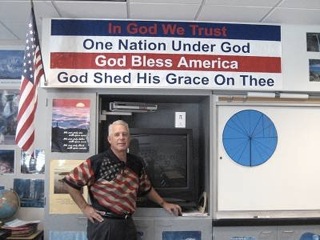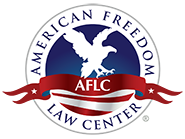 Pursuant to a longstanding school district policy of permitting teachers to express personal, non-curricular messages through the display of banners, posters, flags, and other items and for more than 25 of those years, Bradley Johnson, a high school math teacher, displayed in his classroom, without complaint, two such banners. The banners contain well-known, historic, and patriotic slogans, including “In God We Trust,” “One Nation Under God,” “God Bless America,” “God Shed His Grace On Thee,” and “All Men Are Created Equal, They Are Endowed By Their Creator.”
Pursuant to a longstanding school district policy of permitting teachers to express personal, non-curricular messages through the display of banners, posters, flags, and other items and for more than 25 of those years, Bradley Johnson, a high school math teacher, displayed in his classroom, without complaint, two such banners. The banners contain well-known, historic, and patriotic slogans, including “In God We Trust,” “One Nation Under God,” “God Bless America,” “God Shed His Grace On Thee,” and “All Men Are Created Equal, They Are Endowed By Their Creator.”
In 2007, school officials ordered Johnson to remove the banners because they allegedly conveyed an impermissible “Judeo-Christian” viewpoint. Johnson filed a federal civil rights lawsuit in the U.S. District Court for the Southern District of California. AFLC Senior Counsel Robert Muise represents Johnson.
After more than a year of discovery, the parties filed cross-motions for summary judgment. The federal district court judge ruled in Johnson’s favor on all of his constitutional claims and ordered the school district to allow Johnson to post his banners, which he did. [A copy of the district court’s opinion is available here] The school district eventually appealed the ruling to the U.S. Court of Appeals for the Ninth Circuit. The Ninth Circuit reversed the district court. [A copy of the Ninth Circuit opinion is available here]
In its opinion, the Ninth Circuit, which has a reputation as being hostile toward religion, framed the issue on appeal as follows:
We consider whether a public school district infringes the First Amendment liberties of one of its teachers when it orders him not to use his public position as a pulpit from which to preach his own views on the role of God in our Nation’s history to the captive students in his mathematics classroom.
However, contrary to the panel’s view, Johnson never used “his public position as a pulpit” to “preach” to the students. Dr. William Chiment, who testified on behalf of the school district, confirmed during his sworn testimony that Johnson never proselytized his students.
The lower federal court, which held that the school district did violate Johnson’s constitutional rights, framed the issue differently:
May a school district censor a high school teacher’s expression because it refers to Judeo-Christian views while allowing other teachers to express views on a number of controversial subjects, including religion and anti-religion?
For the past 30 plus years, the school district had in place a policy of permitting teachers to display in their classrooms various non-curricular messages and other items that reflect the individual teacher’s personality, opinions, viewpoints, and values regarding a wide range of interests and subject matter. Consequently, for the past 30 plus years, the classroom walls have served and continue to serve as a forum for the expression of such opinions and viewpoints. As the district court concluded based on the undisputed record evidence:
Defendants have a long-standing policy of permitting its teachers to express ideas on their classroom walls. Defendants’ policy grants its teachers discretion and control over the messages displayed on their classroom walls. Defendants’ policy permits teachers to display on their classroom walls messages and other items that reflect the teacher’s personality, opinions, and values, as well as political and social concerns. Defendants’ policy permits teacher speech so long as the wall display does not materially disrupt school work or cause substantial disorder or interference in the classroom. As a result of the Defendants’ long-standing policy, a teacher’s classroom walls serve as a limited public forum for a teacher to convey non-curriculum messages.
The Ninth Circuit panel acknowledged this factual finding, stating, “[W]e agree with the district court that no genuine issue of material fact remains present in this case,” but disagreed with the application of a forum analysis in favor of a “Pickering-based inquiry,” which requires a balancing of interests. The Ninth Circuit ultimately held that Johnson was speaking pursuant to his official duties so school officials had plenary authority over what he said. Watch the oral argument before the Ninth Circuit below.
The school district also allows a teacher to display a 40-foot string of Tibetan prayer flags, which contain an image of Buddha. These prayer flags are considered sacred, religious items by those who practice Buddhism. Teachers are permitted to display posters of famous religious leaders, such as Gandhi (Hindu), the Dali Lama (Buddhist), and the controversial Malcolm X (the Nation of Islam/Islam); and items of particular political parties or candidates, including a campaign poster of candidate Obama, a Newsweek magazine cover of the candidates Obama and Biden; a poster of the “Libertarian Party”; and the Gadsden flag with the political slogan, “Don’t Tread on Me.”
All of these expressive items were displayed as of April 2009, which is more than two years after school officials ordered Johnson to remove his banners.
For approximately 25 years, Johnson continuously displayed, without a single objection or complaint, his patriotic banners. Johnson had the banners made to order by a private company, and he purchased them with his own funds.
Johnson’s banners contain phrases and slogans central to our Nation’s history and heritage, and they reflect the foundations of our Nation. The banners do not contain quotes or passages from Sacred Scripture or any other religious text.
The classrooms in which Johnson’s banners were displayed were assigned to him. As a matter of policy, teachers are given discretion and control over the various non-curricular messages displayed on their classroom walls. No teacher is permitted to display materials or messages on Johnson’s classroom walls without his permission, and the school district does not direct the teachers’ non-curricular displays; it is up to the individual teacher. As the school officials acknowledged in sworn testimony, the school districtt does not endorse or promote the non-curricular messages displayed by the teachers. Consequently, the teachers’ displays do not constitute government speech.
Johnson’s banners were not displayed pursuant to any of his official duties as a teacher. He did not use his banners during any classroom session or period of instruction. They were not discussed or studied. They caused no material disruption or disorder in his classroom or anywhere else in the school. And they did not interfere with his teaching.
In January 2007, school officials ordered Johnson to take down his banners because they allegedly conveyed an impermissible “Judeo/Christian” viewpoint.
On January 19, 2012, AFLC Senior Counsel Robert Muise filed a petition with the U.S. Supreme Court, asking the high court to grant review of this case and reverse the Ninth Circuit opinion. [A copy of the petition to the U.S. Supreme Court is available here].
UPDATE (March 5, 2012): AFLC Senior Counsel Robert Muise filed a reply brief in the U.S. Supreme Court in support of AFLC’s request that the Court grant review of this important First Amendment case. Read the reply brief here.
UPDATE (March 11, 2012): The case was distributed for the March 23, 2012 conference with the U.S. Supreme Court.
UPDATE (March 26, 2012): The U.S. Supreme Court, without explanation, denied review of the case.
